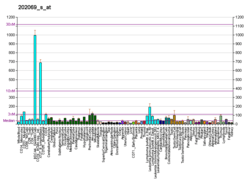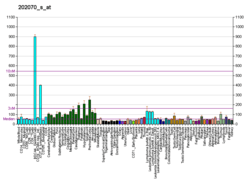IDH3A
Isocitrate dehydrogenase [NAD] subunit alpha, mitochondrial (IDH3α) is an enzyme that in humans is encoded by the IDH3A gene.[5][6]
Isocitrate dehydrogenases (IDHs) catalyze the oxidative decarboxylation of isocitrate to 2-oxoglutarate. These enzymes belong to two distinct subclasses, one of which utilizes NAD(+) as the electron acceptor and the other NADP(+). Five isocitrate dehydrogenases have been reported: three NAD(+)-dependent isocitrate dehydrogenases, which localize to the mitochondrial matrix, and two NADP(+)-dependent isocitrate dehydrogenases, one of which is mitochondrial and the other predominantly cytosolic. NAD(+)-dependent isocitrate dehydrogenases catalyze the allosterically regulated rate-limiting step of the tricarboxylic acid cycle. Each isozyme is a heterotetramer that is composed of two alpha subunits, one beta subunit, and one gamma subunit. The protein encoded by this gene is the alpha subunit of one isozyme of NAD(+)-dependent isocitrate dehydrogenase. [provided by RefSeq, Jul 2008][6]
Structure
IDH3 is one of three isocitrate dehydrogenase isozymes, the other two being IDH1 and IDH2, and encoded by one of five isocitrate dehydrogenase genes, which are IDH1, IDH2, IDH3A, IDH3B, and IDH3G.[7] The genes IDH3A, IDH3B, and IDH3G encode subunits of IDH3, which is a heterotetramer composed of two 37-kDa α subunits (IDH3α), one 39-kDa β subunit (IDH3β), and one 39-kDa γ subunit (IDH3γ), each with distinct isoelectric points.[8][9][10] Alignment of their amino acid sequences reveals ~40% identity between IDH3α and IDH3β, ~42% identity between IDH3α and IDH3γ, and an even closer identity of 53% between IDH3β and IDH3γ, for an overall 34% identity and 23% similarity across all three subunit types.[9][10][11][12] Notably, Arg88 in IDH3α is essential for IDH3 catalytic activity, whereas the equivalent Arg99 in IDH3β and Arg97 in IDH3γ are largely involved in the enzyme’s allosteric regulation by ADP and NAD.[11] Thus, it is possible that these subunits arose from gene duplication of a common ancestral gene, and the original catalytic Arg residue were adapted to allosteric functions in the β- and γ-subunits.[9][11] Likewise, Asp181 in IDH3α is essential for catalysis, while the equivalent Asp192 in IDH3β and Asp190 in IDH3γ enhance NAD- and Mn2+-binding.[9] Since the oxidative decarboxylation catalyzed by IDH3 requires binding of NAD, Mn2+, and the substrate isocitrate, all three subunits participate in the catalytic reaction.[10][11] Moreover, studies of the enzyme in pig heart reveal that the αβ and αγ dimers constitute two binding sites for each of its ligands, including isocitrate, Mn2+, and NAD, in one IDH3 tetramer.[9][10]
Function
As an isocitrate dehydrogenase, IDH3 catalyzes the reversible oxidative decarboxylation of isocitrate to yield α-ketoglutarate (α-KG) and CO2 as part of the TCA cycle in glucose metabolism.[5][8][9][10][11] This step also allows for the concomitant reduction of NAD+ to NADH, which is then used to generate ATP through the electron transport chain. Notably, IDH3 relies on NAD+ as its electron acceptor, as opposed to NADP+ like IDH1 and IDH2.[8][9] IDH3 activity is regulated by the energy needs of the cell: when the cell requires energy, IDH3 is activated by ADP; and when energy is no longer required, IDH3 is inhibited by ATP and NADH.[9][10] This allosteric regulation allows IDH3 to function as a rate-limiting step in the TCA cycle.[5][13] Within cells, IDH3 and its subunits have been observed to localize to the mitochondria.[5][9][10]
Clinical significance
IDH3α expression has been linked to cancer, with high basal expression in multiple cancer cell lines and increased expression indicative of poorer prognosis in cancer patients. IDH3α is proposed to promote tumor growth as a regulator of α-KG, which subsequently regulates HIF-1. HIF-1 is largely known for shifting glucose metabolism from oxidative phosphorylation to aerobic glycolysis in cancer cells (the Warburg effect). Moreover, IDH3α activity leads to angiogenesis and metabolic reprogramming to provide the necessary nutrients for continuous cell growth. Meanwhile, silencing IDH3α is observed to obstruct tumor growth. Thus, IDH3α may prove to be a promising therapeutic target in treating cancer.[8]
IDH3α is also implicated in psychiatric disorders. In particular, IDH3α expression in the cerebellum is observed to be significantly lower for bipolar disorder, major depressive disorder, and schizophrenia. The abnormal IDH3α levels may disrupt mitochondrial function and contribute to the pathogenesis of these disorders.[13]
Mutations in this gene have been associated with autosomal recessive retinitis pigmentosa.[14]
References
- GRCh38: Ensembl release 89: ENSG00000166411 - Ensembl, May 2017
- GRCm38: Ensembl release 89: ENSMUSG00000032279 - Ensembl, May 2017
- "Human PubMed Reference:". National Center for Biotechnology Information, U.S. National Library of Medicine.
- "Mouse PubMed Reference:". National Center for Biotechnology Information, U.S. National Library of Medicine.
- Huh TL, Kim YO, Oh IU, Song BJ, Inazawa J (March 1996). "Assignment of the human mitochondrial NAD+ -specific isocitrate dehydrogenase alpha subunit (IDH3A) gene to 15q25.1-->q25.2by in situ hybridization". Genomics. 32 (2): 295–6. doi:10.1006/geno.1996.0120. PMID 8833160.
- "Entrez Gene: IDH3A isocitrate dehydrogenase 3 (NAD+) alpha".
- Dimitrov L, Hong CS, Yang C, Zhuang Z, Heiss JD (2015). "New developments in the pathogenesis and therapeutic targeting of the IDH1 mutation in glioma". International Journal of Medical Sciences. 12 (3): 201–13. doi:10.7150/ijms.11047. PMC 4323358. PMID 25678837.
- Zeng L, Morinibu A, Kobayashi M, Zhu Y, Wang X, Goto Y, Yeom CJ, Zhao T, Hirota K, Shinomiya K, Itasaka S, Yoshimura M, Guo G, Hammond EM, Hiraoka M, Harada H (September 2015). "Aberrant IDH3α expression promotes malignant tumor growth by inducing HIF-1-mediated metabolic reprogramming and angiogenesis". Oncogene. 34 (36): 4758–66. doi:10.1038/onc.2014.411. PMID 25531325.
- Bzymek KP, Colman RF (May 2007). "Role of alpha-Asp181, beta-Asp192, and gamma-Asp190 in the distinctive subunits of human NAD-specific isocitrate dehydrogenase". Biochemistry. 46 (18): 5391–7. doi:10.1021/bi700061t. PMID 17432878.
- Soundar S, O'hagan M, Fomulu KS, Colman RF (July 2006). "Identification of Mn2+-binding aspartates from alpha, beta, and gamma subunits of human NAD-dependent isocitrate dehydrogenase". The Journal of Biological Chemistry. 281 (30): 21073–81. doi:10.1074/jbc.m602956200. PMID 16737955.
- Soundar S, Park JH, Huh TL, Colman RF (December 2003). "Evaluation by mutagenesis of the importance of 3 arginines in alpha, beta, and gamma subunits of human NAD-dependent isocitrate dehydrogenase". The Journal of Biological Chemistry. 278 (52): 52146–53. doi:10.1074/jbc.m306178200. PMID 14555658.
- Dange M, Colman RF (July 2010). "Each conserved active site tyr in the three subunits of human isocitrate dehydrogenase has a different function". The Journal of Biological Chemistry. 285 (27): 20520–5. doi:10.1074/jbc.m110.115386. PMC 2898308. PMID 20435888.
- Yoshimi N, Futamura T, Bergen SE, Iwayama Y, Ishima T, Sellgren C, Ekman CJ, Jakobsson J, Pålsson E, Kakumoto K, Ohgi Y, Yoshikawa T, Landén M, Hashimoto K (November 2016). "Cerebrospinal fluid metabolomics identifies a key role of isocitrate dehydrogenase in bipolar disorder: evidence in support of mitochondrial dysfunction hypothesis". Molecular Psychiatry. 21 (11): 1504–1510. doi:10.1038/mp.2015.217. PMC 5078854. PMID 26782057.
- Peter VG, Nikopoulos K, Quinodoz M, Granse L, Farinelli P, Superti-Furga A, Andréasson S, Rivolta C (April 2019). "A novel missense variant in IDH3A causes autosomal recessive retinitis pigmentosa". Ophthalmic Genetics. 40 (2): 177–181. doi:10.1080/13816810.2019.1605391. PMID 31012789.
Further reading
- Anderson NL, Anderson NG (November 2002). "The human plasma proteome: history, character, and diagnostic prospects". Molecular & Cellular Proteomics. 1 (11): 845–67. doi:10.1074/mcp.R200007-MCP200. PMID 12488461.
- Kim YO, Oh IU, Park HS, Jeng J, Song BJ, Huh TL (May 1995). "Characterization of a cDNA clone for human NAD(+)-specific isocitrate dehydrogenase alpha-subunit and structural comparison with its isoenzymes from different species". The Biochemical Journal. 308 (Pt 1): 63–8. doi:10.1042/bj3080063. PMC 1136843. PMID 7755589.
- Maruyama K, Sugano S (January 1994). "Oligo-capping: a simple method to replace the cap structure of eukaryotic mRNAs with oligoribonucleotides". Gene. 138 (1–2): 171–4. doi:10.1016/0378-1119(94)90802-8. PMID 8125298.
- Suzuki Y, Yoshitomo-Nakagawa K, Maruyama K, Suyama A, Sugano S (October 1997). "Construction and characterization of a full length-enriched and a 5'-end-enriched cDNA library". Gene. 200 (1–2): 149–56. doi:10.1016/S0378-1119(97)00411-3. PMID 9373149.
- Kim YO, Koh HJ, Kim SH, Jo SH, Huh JW, Jeong KS, Lee IJ, Song BJ, Huh TL (December 1999). "Identification and functional characterization of a novel, tissue-specific NAD(+)-dependent isocitrate dehydrogenase beta subunit isoform". The Journal of Biological Chemistry. 274 (52): 36866–75. doi:10.1074/jbc.274.52.36866. PMID 10601238.
- Weiss C, Zeng Y, Huang J, Sobocka MB, Rushbrook JI (February 2000). "Bovine NAD+-dependent isocitrate dehydrogenase: alternative splicing and tissue-dependent expression of subunit 1". Biochemistry. 39 (7): 1807–16. doi:10.1021/bi991691i. PMID 10677231.
- Adkins JN, Varnum SM, Auberry KJ, Moore RJ, Angell NH, Smith RD, Springer DL, Pounds JG (December 2002). "Toward a human blood serum proteome: analysis by multidimensional separation coupled with mass spectrometry". Molecular & Cellular Proteomics. 1 (12): 947–55. doi:10.1074/mcp.M200066-MCP200. PMID 12543931.
- Soundar S, Park JH, Huh TL, Colman RF (December 2003). "Evaluation by mutagenesis of the importance of 3 arginines in alpha, beta, and gamma subunits of human NAD-dependent isocitrate dehydrogenase". The Journal of Biological Chemistry. 278 (52): 52146–53. doi:10.1074/jbc.M306178200. PMID 14555658.
- Guo D, Han J, Adam BL, Colburn NH, Wang MH, Dong Z, Eizirik DL, She JX, Wang CY (December 2005). "Proteomic analysis of SUMO4 substrates in HEK293 cells under serum starvation-induced stress". Biochemical and Biophysical Research Communications. 337 (4): 1308–18. doi:10.1016/j.bbrc.2005.09.191. PMID 16236267.
- Soundar S, O'hagan M, Fomulu KS, Colman RF (July 2006). "Identification of Mn2+-binding aspartates from alpha, beta, and gamma subunits of human NAD-dependent isocitrate dehydrogenase". The Journal of Biological Chemistry. 281 (30): 21073–81. doi:10.1074/jbc.M602956200. PMID 16737955.
- Bzymek KP, Colman RF (May 2007). "Role of alpha-Asp181, beta-Asp192, and gamma-Asp190 in the distinctive subunits of human NAD-specific isocitrate dehydrogenase". Biochemistry. 46 (18): 5391–7. doi:10.1021/bi700061t. PMID 17432878.





